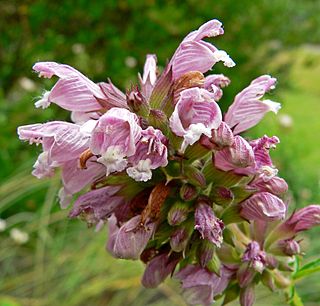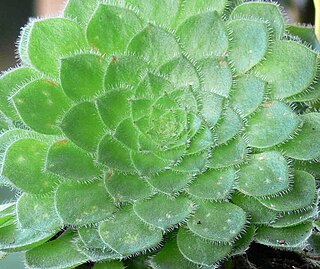
Argyranthemum is a genus of flowering plants belonging to the family Asteraceae. Members of this genus are sometimes also placed in the genus Chrysanthemum.

Cedronella is a genus of flowering plants in the tribe Mentheae of the family Lamiaceae, comprising a single species, Cedronella canariensis, native to the Canary Islands, the Azores, and Madeira. It is also naturalized in various places. Common names include Canary Islands-balm, Canary balm, and Balm-of-Gilead.

Aeonium nobile is a succulent, subtropical flowering plant in the family Crassulaceae. It is native to the island of La Palma in the Canary Islands, where it grows on dry slopes and cliffs at altitudes up to 800m. The inflorescences are large and spreading with bright red flowers.

Euphorbia bourgaeana is a species of flowering plant in the spurge family Euphorbiaceae. It is native to Tenerife in the Canary Islands.

Euphorbia canariensis, commonly known as the Canary Island spurge, Hercules club or in Spanish cardón, is a succulent member of the genus Euphorbia and family Euphorbiaceae endemic to the Canary Islands. It is the plant symbol of the island of Gran Canaria.

Hypericum canariense is a species of Hypericum known by the common name Canary Islands St. John's wort. It is the sole member of Hypericumsect. Webbia.

Spartocytisus supranubius is a white-flowered species of broom endemic to the Canary Islands and known there by the common name retama del Teide. S. supranubius is a high mountain species, occurring at about 2000m altitude on Tenerife in Las Cañadas del Teide and on mountain tops on La Palma.

Argyranthemum frutescens, known as Paris daisy, marguerite or marguerite daisy, is a perennial plant known for its flowers. It is native to the Canary Islands. Hybrids derived from this species are widely cultivated as ornamental plants in private gardens and public parks in many countries, and have naturalized in Italy and southern California. There are many cultivars, but the most common has white petals.

Aeonium ciliatum is a species of flowering plant in the family Crassulaceae that produces large green leaf rosettes, which can be 50 cm across. The rosettes emerge from a woody stem that branches freely and can become very top heavy. It is endemic to Tenerife in the Canary Islands, where it prefers some shade, and is frequent in the Anaga peninsula in the north east of the island.

Aeonium hierrense is a species of succulent flowering plant in the family Crassulaceae that is endemic to the island of El Hierro in the Canary islands. It has whorls of strongly ciliate leaves borne on a stem up to 1m in height. The leaves takes on an attractive purple colour during the summer, being quite green in the winter. It produces whitish pink flowers that have 8-fold symmetry.

Aeonium tabuliforme, the flat-topped aeonium or saucer plant, is a species of succulent plant in the family Crassulaceae, native and endemic to Tenerife in the Canary Islands. It grows on moist, north-facing cliffs and ledges at low altitude. A mass of fleshy, hairy, bright green leaves in flat rosettes, is produced on short unbranched stems, often on vertical surfaces.

Aeonium urbicum is a succulent species of flowering plant in the family Crassulaceae. It is endemic to Tenerife, one of the Canary Islands, where it frows on the north of the island from Teno point to the Anaga peninsula. Until 1999, it was also considered a resident of La Gomera, another Canary Island, but that year the populations on that island were considered a new species and named Aeonium appendiculatum.

Hypericum grandifolium is a species of flowering plant in the family Hypericaceae. It is native to Madeira and the Canary Islands. It is an evergreen shrub up to 1.8 m in height, with dark green, leathery leaves covered with warty glands, and bright yellow flowers up to 4.5 cm broad. It is an important constituent of the shrub layer in the laurisilva of La Gomera.

Gesnouinia is a small genus of flowering plants in the family Urticaceae. Two species are accepted by The Plant List as of October 2014:

Sonchus congestus is a species of flowering plant in the family Asteraceae. It is endemic to the Canary Islands.

Helianthemum canariense is a species of flowering plant in the family Cistaceae, native to Western Sahara, Morocco and the Canary Islands.

Euphorbia regis-jubae is a species of flowering plant in the family Euphorbiaceae, native to the eastern Canary Islands, western Morocco, north-western Western Sahara. In Spanish, it is known as tabaiba morisca. It has often been confused with Euphorbia lamarckii.

Heliotropium crispum is a species of flowering plant in the family Boraginaceae, native to northern Africa, temperate Asia, and Pakistan. It was first described by René Louiche Desfontaines.

Pericallis echinata is a species of flowering plant in the family Asteraceae. It is native to Tenerife in the Canary Islands.

Artemisia thuscula (Incienso) is a species endemic to the Canary Islands. It is frequent in dry areas at lower elevations. Its capitula are globose and leaf lobes flat.






















